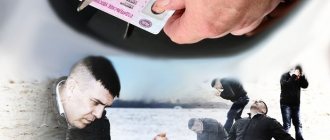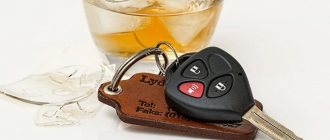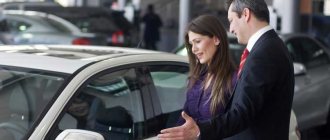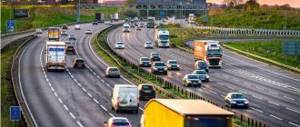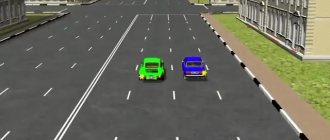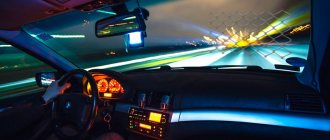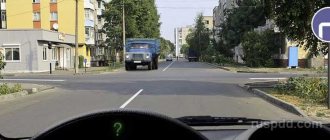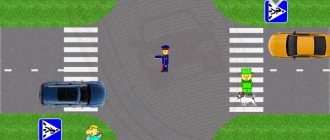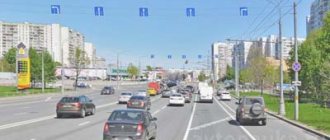Traffic rules concerning cyclists
Many fans of muscle riding do not even suspect that there are rules for them, so they fearlessly go on the roads. Such carefree reckless drivers can easily run into a fine when meeting with a traffic police inspector. Separate traffic rules for cyclists have not yet been issued. Their rights and obligations are set out in the traffic rules for vehicles, which include two-wheelers in paragraph 1.2. Consequently, all the requirements regarding motor vehicles must also be met by the owners of “big bikes”. But in section 24, 6 paragraphs are directly devoted to them.
Rights and responsibilities of a cyclist on the road in accordance with traffic regulations
7 minutes Author: Mikhail Skvortsov 2338
A cyclist is the same driver of a vehicle as someone sitting behind the wheel of a car or motorcycle, so he must comply with the traffic rules in force in his country. This means no drinking while driving, no talking on a cell phone while driving, no turning around in solid lanes, no driving in the opposite direction on a one-way road. The main responsibilities of a cyclist are set out in a separate section of the Rules of the Road.
Basic provisions
Any person who wants to purchase a two-wheeled friend should know that with it he also acquires responsibility for the safety of other people. Therefore, you need to clearly know what this unit is from a legal point of view.
Bicycle as a vehicle
A device with a steering wheel and pedals, as the traffic rules for cyclists state, belongs to vehicles. Consequently, their owners are equal to drivers of cars, trucks, trolleybuses and buses. They, just like the driver of the KamAZ, are road users. This imposes a certain responsibility on cyclists and obliges them to behave correctly on the roads, without interfering with the movement of vehicles and pedestrians. Moreover, in the event of an accident, drivers of two-wheeled vehicles suffer first of all, since they are not protected by the body, unlike motorists.
Who can control
Manufacturers produce a huge number of bicycle models for all ages. Therefore, you can see both a three-year-old child and a pensioner driving such a device. It is clear that small children should travel on their three-wheeled units only when accompanied by adults and under their constant supervision, since they often do not know where they are going. The movement area for children is limited to pedestrian paths and sidewalks.
As for independent movement, there are age restrictions on movement in certain places.
Children from 7 to 14 years old can travel:
- along pedestrian areas;
- bicycle pedestrian and bicycle paths;
- pedestrian paths;
- sidewalks.
Starting from the age of 14, when a bicycle turns from a device for walking into a vehicle, its owner is allowed to ride in other places. At the same time, a list of rules appears, which are ordered to be strictly followed. If one or more of the top items from this list are absent in the road situation, you should be guided by the item below.
Movement is allowed:
- Along a bicycle lane or path, a bicycle pedestrian path.
- On the right edge of the road.
- On the side of the road.
- On the sidewalk, pedestrian path.
For example, if there is no bicycle lane or bicycle pedestrian path, you must go to step 2 and move along the right edge of the roadway. If this is also impossible (heavy traffic), you need to follow step 3 and pull over to the side of the road.
Cyclists' rights
Despite the fact that bicycles are classified as vehicles, their owners have limited rights, and this was done for safety reasons. Not all lanes of the roadway are accessible to two-wheelers, and even in the far right lane, they are only allowed to ride on the edge of the road.
But cyclists have the right to move:
- on the side of the road;
- along bicycle and bicycle-pedestrian paths;
- on sidewalks, provided that driving does not interfere with the movement of pedestrians.
Otherwise, you will have to drive the bike by the steering wheel. In this situation, its owner automatically becomes a pedestrian. If he collides with a car moving on the sidewalk (and in some cases this is allowed), he will not be at fault. But the cyclist driving will have to pay for car repairs if his guilt is proven.
Responsibilities
The driver of a two-wheeled unit must comply with all requirements for the movement of cyclists set out in the traffic rules.
He is obliged:
- keep the vehicle in technically sound condition;
- do not interfere with traffic;
- allow pedestrians to pass at intersections;
- do not interfere with the movement of passers-by on the sidewalks;
- in conditions of insufficient visibility, use light devices;
- Before turns, indicate changes in direction of travel with signs.
Will the bicycle become a means of transport in 2021?
According to the traffic rules, a bicycle is a non-motorized vehicle. According to the rules, electric bicycles are equal to mopeds. They are classified as motor vehicles when equipped with an engine. The cyclist, accordingly, becomes a bicycle driver. On him
The following traffic rules apply:
- on public roads;
- as for a pedestrian, in all other cases.
The rules also contain separate clauses that are relevant specifically for cyclists. Whether a bicycle is a vehicle or not depends on the position of the cyclist. Despite the fact that you do not need to pass an exam at the traffic police to ride a bicycle, administrative liability is imposed for violating the rules.
Basic traffic rules
To ride a bicycle safely, you must follow the rules of the road, because this vehicle can reach a decent speed - up to 40 km/h, and a sports vehicle with a set of gears - even more. If you speed up and lose control of the situation, you can hit a person and get into an accident. Therefore you need to be extremely careful.
Maneuver signals
When moving along the roadway, bicycle enthusiasts must warn other road users about upcoming maneuvers. Before turning left (right), you must move your left (right) hand to the side. It is worth noting that turning left, except for cases specifically specified in the traffic rules, is prohibited for cyclists. In this situation, before the intersection you need to go down and cross it in pedestrian mode, leading your “iron horse” by the steering wheel, and then get back on the bike and continue to follow the intended route. Before braking, you need to extend your right or left arm up.
When driving in a convoy, another signal is used. It is served to those riding behind. A hand lowered down indicates the presence of a hole on the side from which the limb is lowered. It is better not to use a bent arm at the elbow to give signals (they are for car drivers), so as not to mislead those driving behind.
Lanes and lanes
Road markings are made for cars, so cyclists are only allowed to ride in the right lane closer to the side of the road, so as not to interfere with other vehicles whose speed is much higher. Cyclists are prohibited from traveling on expressways. You can't change lanes either. The exception is making a U-turn when there is no other vehicle on the road.
If cycling enthusiasts ride in a convoy, they must adhere to special rules:
- move only in one row;
- with a bike width of no more than 0.75 m, 2-row traffic is allowed;
- a large column is divided into groups of 10 bikers or pairs (with 2-row traffic);
- a distance of 80-100 m is maintained between groups (to facilitate overtaking).
Bikers are allowed to overtake other vehicles if the maneuver does not interfere with other road users. Overtaking takes place on the left side.
Behavior at traffic lights
Cyclists, like other vehicle drivers, must carefully monitor traffic lights and follow them strictly: stop when they are red and start moving when the light turns green. But they have one advantage - switching to pedestrian mode. If you use this wisely, you can reduce the time you spend at an intersection. When riding on the sidewalk, approaching an intersection, you need to get off your bike.
You cannot cross an intersection at a pedestrian crossing on a bike. You need to drive him. Having completed the transition, you can saddle the “iron horse” again.
If the road has only one lane for traffic and there are no tram tracks, the cyclist is allowed to turn left.
Crossing intersections
When the situation at the intersection is regulated by traffic lights, everything is much simpler. All that remains is to carefully monitor the signals and follow them correctly. At uncontrolled intersections, you need to know the rules for their passage, which are published in the traffic rules. First, all traffic moving along the main road is allowed through. If the roads at the intersection are equal, when driving straight ahead, traffic moving in the transverse direction on the right side is first allowed through. When turning left (which in most cases is prohibited for cyclists), all vehicles moving on the right and directly in the oncoming direction are allowed to pass.
To make the rules for driving through an intersection easier to remember, among drivers there is the concept of “obstacle on the right.” When moving straight or to the left, you must give way to all traffic located to the right of the biker. A car approaching in the oncoming lane, if the bicycle driver decides to turn left in front of him, will also become an “interference on the right”, therefore, you must definitely let it pass.
It turns out that the easiest thing to do at an uncontrolled intersection is to turn right. But for lovers of cycling, it is not easy when there is a car nearby, also turning right. In this situation, the bike may end up in a blind spot, the motorist will not notice it and will begin a maneuver, risking injury to the person driving the bike. The same thing can happen if the driver of a car wants to make a right turn, and the owner of a bicycle is riding straight next to him.
You need to pay attention in other situations as well. Even if you are confident that you are right, before starting the maneuver you should make sure that other drivers see the cyclist and know in which direction he will start moving next.
Transportation of children
Families often use two-wheeled vehicles to take their children to kindergarten. At the same time, they wonder whether transporting children by bicycle is prohibited. Children under 7 years old can only be transported with a special seat, which is attached either to the frame or to the trunk. In the first case, the child can be seen during transportation, and this is a huge plus, but it is much more comfortable for children to ride in the back seat. Children over 7 years of age and adult passengers can also be transported if this is provided for by the design of the bicycle. You can find out about this in the instruction manual.
Behavior at pedestrian crossings
Here the biker can behave both as a driver and as a pedestrian. In the first case, when approaching a pedestrian crossing, he must brake and allow pedestrians to cross the roadway without hindrance. In the second case, the bicycle is driven by the handlebars next to you, moving along the crossing in the same flow as pedestrians.
Illuminated bicycle markings
Riding in the dark is dangerous, so all bikes must be equipped with light markers. Retroreflective elements are installed on both sides of each wheel. There should also be lanterns. The front is white, the back is red.
The greatest danger is driving without illuminated signs in the fall, when there is no snow yet. In such a situation, car drivers do not see a cyclist moving along the edge of the roadway until he falls into the beam of headlights. When this happens, the driver of the car has too little time to react, so the largest number of hit-and-run bikers occurs during this period.
Duties of a cyclist
A cyclist is required to equip his bicycle with headlights. The front is white and the back is red, just like a car. The wheels at the back, front and sides should be equipped with reflectors so that in the dark other drivers can understand who is driving ahead. The bicycle must also have a handlebar, brake system and sound signal in perfect condition. To carry passengers there must be a special seat attached to the trunk or frame . This applies to the transportation of preschool children.
A cyclist must travel along the highway in the far right lane if there is no bicycle path on this section. If there is one, then you are allowed to move only along it. On the highway, a cyclist moves in the same direction of travel as other vehicles, and not towards them.
Bicycle columns must move in one row, the maximum number is 10 people. If the group of athletes is larger, it is necessary to divide into 2, 3 or more columns depending on the number of cyclists. The distance between columns must be at least 80 meters to provide sufficient maneuvering space for vehicles.
A bicycle does not have turn signals, but nevertheless, the person driving this vehicle is obliged to give signals indicating his intentions. If he wants to make a turn to the left, then he shows it with his left hand extended in that direction, if to the right, then with his right hand. When a cyclist wants to stop, he must extend one arm high up.
Cyclists are allowed to travel on sidewalks only if they are transporting a preschool-aged passenger or those accompanying a convoy of schoolchildren. If a cyclist interferes with the movement of pedestrians, then he is obliged to continue his journey, dismounting to the ground, like a pedestrian. He will be able to get behind the wheel of a bicycle again on freer sections of the road.
Major violations
The most common violation is cycling in a pedestrian crossing. Moreover, the bikers themselves do not consider this a violation. Drivers are not required to let bikers pass at the crossing, because they are not pedestrians. That's why they are often hit by cars. During school holidays, many children suffer from ignorance of this nuance. Pedestrians can also be injured when the flow is dense and the speed of the two-wheeled vehicle is high.
The second most common violation is driving along the edge of the road in the opposite direction. Pedestrians are allowed to do this if there is no sidewalk nearby. But cyclists do not relate to them when they are sitting in the saddle, although they sincerely believe that in this case they are doing the right thing.
Other disorders that are less common include:
- riding without hands;
- transportation of children and passengers on bikes not intended for this purpose;
- transportation of oversized cargo, when the luggage extends beyond the dimensions of the bicycle by more than half a meter in width;
- driving on highways;
- left turn when there are two or more traffic lanes, as well as tram tracks;
- using a bike as a tow vehicle.
Prohibitions and offenses
Along with the responsibilities, there are also prohibitions that are provided for in clause 24.8 of the traffic rules. It lists what is strictly prohibited for a cyclist.
- Let go of the bicycle handlebars when moving anywhere. This applies to highways, sidewalks and dedicated bike paths.
- Transportation of cargo that does not comply with the permissible standards in terms of dimensions. The load should not protrude more than half a meter in any direction.
- Transporting passengers on a bicycle that does not have special equipment.
- Ride a bicycle on a pedestrian crossing. It is necessary to dismount.
- Move without a special helmet or with the fasteners unfastened.
- Make a U-turn or turn left on tram lines and on roads where several lanes are marked.
- Do not tow anything other than trailers.
- Driving while under the influence of alcohol or drugs.
- Driving after taking intoxicating or potent drugs.
- Use the motorway if there is a bike path nearby.
- Drive on the sides of the road or along medians.
- Transfer the driving of a bicycle to another person who has traveled a long distance without rest, is drunk, under the influence of drugs, or is taking strong medications.
- Communicate on the phone without a headset while driving.
Fines for cyclists
It is noteworthy that in the Code of Administrative Offenses (CAO) a bicycle is not classified as a vehicle, but there is a special article 12.29 dedicated to violations by bicycle bikers. A fine of 800 rubles is imposed if traffic rules are violated while sober, and from 100 to 1,500 rubles if the biker was intoxicated.
If the driver of a two-wheeled vehicle moves in pedestrian mode, another article of the Code of Administrative Offenses applies to him - 12.30. In case of interference with another vehicle, a fine of 1 thousand rubles is imposed for the violation. If you cause harm to health of mild or moderate severity, you will have to pay a fine of 1,500 rubles.
Bicycle drivers are prohibited
1. Drive without holding the steering wheel with at least one hand. Adults usually use bicycles as a means of transport, while children ride them for fun. It is irresponsible cyclists who, when riding on the roadway, can let go of the steering wheel and ride on, crossing their arms over their chest. If the would-be reckless driver falls, he will sprawl out on the asphalt along with his bicycle, and it is possible that he will be hit by passing cars.
2. Ride on sidewalks, pedestrian paths and roadsides. The license still allows driving on the side of the road, you just need to not interfere with pedestrians walking along it or getting on the bus. Well, pedestrian paths or sidewalks are intended only for pedestrians, and every person should feel safe when moving on them.
3. Travel on highways. This ban is based on the health and safety of cyclists.
4. Turn left or make a U-turn on a road that has tram tracks or more than one lane in a particular direction. If you need to turn or turn around, you need to get to the pedestrian crossing, get off your bike and roll it to the opposite side of the road.
5. Tow a bicycle with another vehicle. It is allowed to transport a trailer with a rigid coupling by bicycle.
An attempt to drive while grabbing the side of a truck often ends in tragic consequences. In this case, the truck driver does not see the cyclist attached and does not think about his safety. Any car can move at speeds over 60 km per hour. When avoiding a pothole on the road or performing emergency braking, a hitchhiker may find himself under the wheels.
6. Carry cargo that protrudes beyond the dimensions in width or length by more than 0.5 meters and interferes with control. Fishing rods, pipes and some kind of sticks on a bicycle disturb the stable position, especially when making turns. If a vehicle catches a protruding object, it can overturn a bicycle with a hook.
7. Take adult passengers for rides. And you can transport children aged 2 to 7 years, but only on an additionally installed seat with footrests. When transporting a heavy person on the frame or roof rack, the previously mentioned stable position is seriously compromised.
Is a cyclist a pedestrian or a driver?
A lot of questions usually arise: who should be considered a cyclist - a pedestrian or a driver? A cyclist most often turns out to be a “black sheep”: motorists consider him a pedestrian, pedestrians consider him a driver. What is written about this in the Rules?
Anyone who has read the Rules casually or does not want to bother searching for the necessary articles will point to the definitions in Article 1.2:
“Cyclist” is a person driving a bicycle.
“Driver” is a person driving a vehicle, a driver leading pack animals, riding animals or a herd along the road. A driving instructor is treated like a driver.
Will he be right? Partially. Because the same article 1.2 tells us:
“Pedestrian” is a person who is outside a vehicle on the road or on a pedestrian or bicycle path and is not working on them. Pedestrians include persons moving in wheelchairs without a motor, driving a bicycle, moped, motorcycle, carrying a sled, cart, baby stroller or wheelchair, as well as using roller skates, scooters and other similar means for movement.
What is the difference? Elementary. If you sit behind the wheel of a bicycle, spin the pedals and ride it, whistling some cheerful tune - you are a driver. If you get off your bike and peacefully walk it next to you, you are a pedestrian. This is very convenient: if you want, you become a driver, if you want, you become a pedestrian! But keep in mind that depending on whether you are a driver or a pedestrian, you will be subject to rules only for drivers or only for pedestrians. For example, when crossing the road at a pedestrian crossing, dismount. The crossing is pedestrian. However, more on this later...
Penalty for failure to give a hand signal
If you neglect the need to give a turn signal, the traffic police officer has the right to issue a fine. After all, this is a gross violation of traffic rules. The largest amount is provided for cyclists - 800 rubles. Drivers of cars, motorcycles and mopeds will have to pay 500 rubles or get a warning for the first time.
It is worth noting that timely signals are needed not only to avoid punishment. If the turn signals are not working or are missing, it is very important to warn other road users about the upcoming maneuver. Otherwise, there is a high risk of causing an accident.
2.3. Cyclist - driver of a vehicle
The driver is the main figure in ensuring road traffic.
Let us remind you that in our country the number of cars is growing at a high rate: every year there are approximately 1,300,000 more cars. According to experts' forecasts, in the near future there will be 330-440 cars per 1000 people (in 2009, this figure averaged 225 cars).
Consequently, the number of drivers is also growing rapidly. At the same time, the level of their professional training and level of culture in the field of road safety is not very high and does not fully meet the increasing requirements for road users to ensure road safety in modern conditions (as already mentioned, more than 70% of road accidents occur due to the fault of drivers ).
Therefore, road safety primarily depends on the level of training of drivers and instilling in them a high sense of responsibility for personal safety and the safety of others.
Here are the vehicles you don't need a driver's license for
The constant increase in the cost of fuel at gas stations, rather high taxes, insurance, fines, the increase in the cost of auto parts and maintenance, along with the development of public transport, taxis and car sharing, forces many people to abandon their personal cars. This means that there are people who do not need a driver's license. But what if you don’t have a driver’s license or have been deprived of one? Is there really no alternative but to take public transport or take walking tours? In fact, there are options. Did you know that there are a number of vehicles that do not require a driver's license to drive? You will be surprised, but this is not only a bicycle.
The list of vehicles that can be driven without a license is small, but it contains elements that will certainly make life easier for someone. Let's start with the most famous and popular transport in the world:

